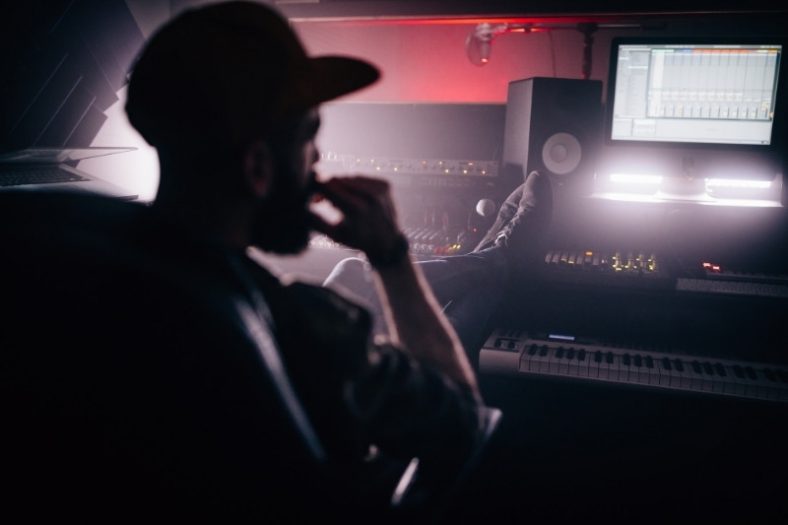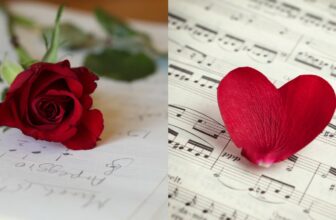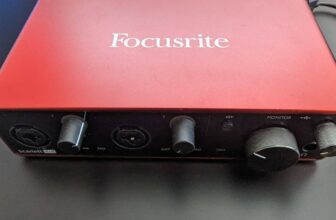How to Arrange a Song in 7 Steps

Song arrangement is about taking a musical idea and organizing it to create a song that flows from start to finish. Arrangements should have a cohesive structure, divided by recognizable sections. Choosing the instruments that make up a song (voicing) is also an important part of song arrangement.
Contents
- What is the difference between arranging and composing?
- What goes into arranging a song?
- What is the structure of an arrangement?
- What is the voicing of an arrangement?
- 1. Lay it down first, make decisions later
- 2. Find your song’s hook and work around it
- 3. Create a suitable intro
- 4. Add new layers to make reused sections sound fresh
- 5. A chorus is only as good as its pre-chorus
- 6. Insert silences to create momentum
- 7. Add sound design effects to better fit the listener’s expectations
- Summary
What is the difference between arranging and composing?
Arranging is the process of structuring and outlining a song that makes sense using a musical idea you already have. Composing is about coming up with something new out of nothing, hence creating the source material you’ll use during the arrangement process.
Imagine that you’ve written a nice song with the acoustic guitar, but you want to turn it into a modern pop hit. This is an example of taking a musical composition and reworking it to create a completed song (i.e., arranging it). The same happens if you have a basic loop in your DAW (composition) and you want to extend it to create a full song.
In a nutshell, arranging is about using structuring and voicing to make the most of any previously-composed musical idea. It’s the process of coming up with a song that feels finished, discernible, and releasable (in the sense that it’s a “product” that could be streamed or played on the radio).
What goes into arranging a song?
To convincingly arrange a song, you need to be aware of two things: structure and voicing. In case you want your song to be commercially released, mixing (optimizing the song by balancing and processing the different sounds it contains) also plays an important part.
What is the structure of an arrangement?
The structure of an arrangement refers to the way the song flows, concerning the different sections of a song and their relative positions. There are no objective rules for making a good structure, but most songs tend to involve at least two or three different sections.
These are the fundamental types of song section every producer should know about:
Intro: A short musical section that’s used to introduce the song. It should grab the listener’s attention immediately, but without giving too much away.
Verse: One of the fundamental sections of any song, normally used to tell a story. The verse should be catchy and engaging, but it shouldn’t exhaust the full potential of the song. Think of it as the song’s “home,” the place from which everything else will derive.
Pre-chorus: A short musical section that’s used to highlight the chorus. Not all songs feature a pre-chorus, but the ones that do use it to announce the chorus and make it hit harder.
Chorus: The life and soul of any song, the chorus should be its most energetic and exciting moment. A good chorus will stick in the listener’s mind for the entire day. Whereas the verse should be grounded and “homely,” the chorus should be explosive and adventurous.
Bridge: A section that adds variety to the song. It’s normally used instead of the verse (to avoid excessive repetition) and resolved into the chorus.
What is the voicing of an arrangement?
The voicing of an arrangement concerns the sounds that go into playing each layer of the song. Voicing a song is determining the way it sounds by building a cohesive sonic palette that works well together.
Imagine that you’ve composed a sweet riff on the electric guitar. Voicing is the process of taking that riff and deciding which instrument (or timbre) should play it. More than that, it’s also the process of deciding which sounds go well with the riff, hence creating the entire sonic nature of the song.
Now that you know what song arrangement is all about, it’s time to cut to the chase and take a closer look at how to arrange a song. The following steps should help you to come up with a full song that makes sense and keeps the listener engaged.
1. Lay it down first, make decisions later
The first step to creating a nice song arrangement is to lay out your song, loops, or basic ideas in a way that can at least be perceived as a full song.
Arranging a song is not about you, the musician/producer. It’s about the listener. That’s why it’s so important to listen to what you have before starting to make arranging decisions.
To do so, you should start by finding the song’s tempo. If you’re working inside a DAW, you already have a defined BPM to work with. If you’re working outside the realm of electronic music, committing to a BPM should be your first step.
One of the basic elements of song arrangement is to stick to a consistent metric. Unless you’re doing something pretty crazy, you should follow the same time signature from start to finish (for example, 4/4 at 120 BPM).
Laying out whatever you have in a song-like format is very helpful because it allows you to play back the unfinished arrangement and to perceive it as the listener. To make proper arranging decisions, you should become the song’s listener and judge it not as an insider (i.e., the person who composed the song) but as someone who’s listening to it for the first time.
Balancing what the listener expects to happen with something the listener will find surprising is at the very core of song arrangement.
2. Find your song’s hook and work around it
Usually, musicians and producers will only write an arrangement if they have something “tasty” that they consider unique. That’s the hook: the bit of the song that is good enough to justify its existence.
Anything can be a hook: from a groovy bassline to a powerful vocal section, from a catchy guitar riff to a dreamy chord progression. But in a nutshell, the hook is the sound or combination of sounds that makes your song special. So, why not make arranging decisions based on the hook?
This is particularly important for shaping the voicing of the arrangement. Try to come up with sounds that make your hook sound better and your song sound fuller. A decent song arrangement can have as little as two or three tracks and as many as 100 or more layers. But either way, it should sound complete, without any missing pieces.
Here are some tips for making a hook sound more full:
Add extra layers of sound – If your hook doesn’t sound big enough, a good way to make it pop out is to add extra layers of sound. Just duplicate the hook and play it using other instruments for a wider frequency range.
For a bassline hook, for instance, why not add a short synth pluck to make it sound more “stabby?” For a vocal passage, why not create some extra width by playing the notes of the voice in an accompanying pad?
Introduce it little by little – If you have a great hook, you should make the most of it. Introduce it little by little in the song to add variety and make it feel more catchy and structured. This may not work for all hooks, but it’s a wonderful technique if used correctly. For a fine example, check the song “Papa Was a Rolling Stone,” by The Temptations.
Take it away, just to give it back – A great hook is there to be repeated, but even the best riffs and melodic lines shouldn’t play non-stop in the context of a song. Take the hook away by creating suspenseful pauses and give it back for a more impactful listening experience.
You can achieve this by doing something as simple as adding some tension to the final measure of the beat: in my experience, a four-note repeat or a short drum break should do the trick.
3. Create a suitable intro
Creating a captivating intro is an excellent technique to pique a listener’s interest immediately and keep them listening.
The arrangement of a song (i.e., its flow) is what keeps a listener engaged. If your arrangement is good, the listener will stick around and listen to the story you have to tell. But to grab a listener’s attention right at the start (a must in today’s music-streaming world), there’s nothing quite like coming up with a suitable intro.
What’s a suitable intro? Well, it depends. But all good-sounding intros should do at least three things: resolve satisfyingly into the first verse of the song, introduce one or more core elements of the song, and sound interesting enough to grab the listener’s attention.
Conservatively, intros tend to use the main chord progression of the song to get the listener into the right mood. Sometimes, they are made up of just the instrumental version of the main verses. In other cases, they are composed of a simple sound effect or music technique—like Pharrell Williams’ signature four-count start.
Whenever I’m trying to come up with an intro and feel blocked, I like to copy the instrumental version of the main verses and add a filter. Then I automate a high-pass with a bit of resonance, so the higher frequencies of the verses can be slowly revealed.
This is an easy way of creating a sense of suspense, tension, and familiarity in the intro of a song. My go-to tool for this effect is Ableton Live’s Auto Filter, but any EQ should do.
4. Add new layers to make reused sections sound fresh
Repetition is a must in the arrangement of a song. You don’t want to overuse it, but you don’t want to snub it either.
Unless you’re cooking up a crazy progressive rock track, your song will not sound good if every section is radically different from the other. However, it can be boring to go from the verses to the chorus and back to the verses without adding anything new.
Coming up with new layers for reused sections of a song is one of the simplest but most powerful arranging techniques out there. And the best part is that, since the listener is already familiar with the verses by the time the second verses appear, you can get very creative without making the song sound overbearing. The same applies to the second and third choruses.
Add a new layer of percussion to the second verses to make them groove a bit faster and sound a bit fuller. For second choruses, additional vocals (especially background vocals) tend to do the trick.
Naturally, though, you can get as creative as you want: the goal here is to present the listener with something he or she already knows, but with an added new detail to keep his/her interest.
5. A chorus is only as good as its pre-chorus
What makes a chorus great? Well, if there was an infallible formula to come up with a memorable chorus, we would all have number-one hits.
We can all agree that the greatest choruses in history are ultimately catchy—meaning you should probably learn more about what makes a song catchy.
But a good chorus isn’t characterized solely by its catchiness, but also by its setup. In other words, a chorus is only as good as its pre-chorus. A chorus should make sense in the context of a song and hit the listener hard when it first comes in. The last thing you want from a chorus is for it to create a sense of strangeness, to sound like something that doesn’t belong in the song.
With this in mind, coming up with a great pre-chorus is a certified way of making a song arrangement more interesting. Pre-choruses can be as simple or complex as you want, but they should have an essentially practical function: more than sounding good on its own, the pre-chorus needs to make the chorus sound good.
6. Insert silences to create momentum
The motto “less is more” is very useful when it comes to song arrangement. One of the best ways to add variety and suspense to a song is not by introducing new elements, but by taking elements away.
This works wonders in pop tunes led by a powerful vocal: take away the instrumental for a bit and leave the vocals playing in solo for a more impactful return of the instrumental. If you don’t know how to go from the verses to the chorus (or vice-versa), this little trick should be all you need to come up with a decent transition in less than a minute.
Have you ever wondered why so many dance-club hits break to silence before the drop? That’s because silence creates an impactful sense of rupture that immediately grabs the listener’s attention!
Once your arrangement is flowing nicely, try to remove instruments from key moments of the song to add more impact. Experiment freely with as many combinations as you want, and I’m sure you’ll find something interesting.
7. Add sound design effects to better fit the listener’s expectations
Song arrangement is hard because it’s essentially not about music theory or audio production techniques. It’s about human psychology. The goal is to tell a story to the listener in a language that he or she can understand.
For this reason, arranging is about predicting what the listeners’ expectations will be at a given moment and creating satisfying solutions to fit such expectations. And that’s when sound design effects come in handy.
Sound design effects can be as simple as a pre-chorus riser or a reverberated impact sound. But they’re extremely helpful for arranging a song because they’re a direct match to the listener’s expectations.
Imagine you’re at the club, and you start to listen to an exponentially faster clap roll; you already know that a drop is coming. Imagine you’re listening to a drum and bass song that breaks into a crash cymbal with a slow-decaying reverb; the moment you listen to it, you already know that you’ve arrived at the breakdown.
Some sound design effects are so familiar that they can be used to manipulate the listener’s expectations. If applied correctly, these sound design effects can make an unexpected moment in a song sound predictably satisfying from a clueless listener’s point-of-view.
Once you’re done with your arrangement, upgrade its flow by adding sound design effects that create tension (such as risers) or release (such as impacts) to better fit the listener’s expectations.
Summary
Song arrangement is not a definite science, nor something you can be good at just by following a series of rules. But with experience, a trained ear, and a sense of respect for the listener, every musician/producer can turn a boring, repetitive loop into an exciting sonic journey that tells a story from start to finish.
Focus on creating a cohesive arrangement and always start with a simple approach. Don’t get too creative with time signatures unless you have to, and be patient: in my experience, arranging is the most time-consuming task of the music-making process.
In case you need some extra help with your songs, these 10 great songwriting tools should help you to keep the juices flowing.





